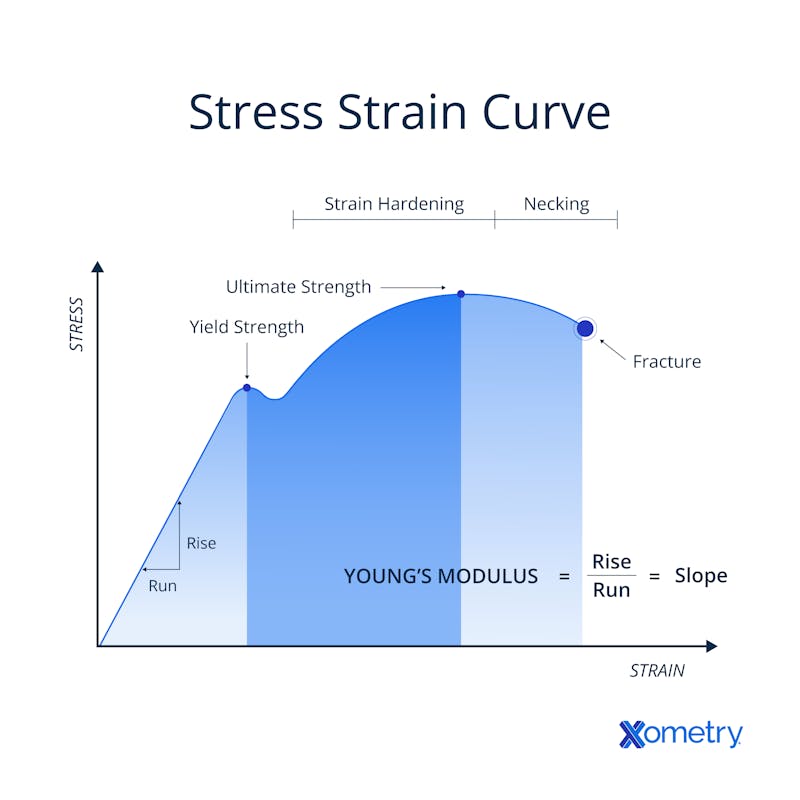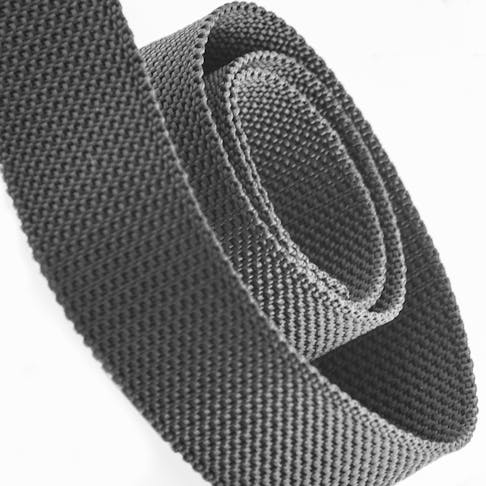The yield point is the point on a material’s stress-strain graph at which it stops deforming elastically and starts deforming plastically. During elastic deformation, the material will return to its original dimensions, but plastic deformation changes its shape permanently.
In many cases, the yield point on a stress-vs-strain curve can be identified as the point where linear deformation stops and the curve dips down again before rising to the ultimate tensile strength point. Some yield points are not evident to the eye on a stress-strain graph. Therefore, the point is chosen using an industry convention. First, a 0.2% offset is added to all strain values on the linear part of the graph. That shifts the line slightly to the right. The spot where the new line and old curve intersect is the yield point. The temperature and strain rate of the material can affect the yield point in opposing ways. Strain hardening can also influence the yield point of metals.
This article will discuss the yield point, its key characteristics, applications, and the factors that affect it.
What Is the Yield Point?
The yield point is a mechanical property that marks the transition from elastic to plastic deformation in a material. Below this point, the material will deform elastically and return to its original shape when the load is removed. Once the yield point is exceeded, the deformation becomes permanent. The yield point is typically determined through tensile testing, where a specimen is subjected to increasing uniaxial stress until this threshold is identified.
How Does the Yield Point Differ From the Elastic Limit in Materials?
The yield point and the elastic limit are different characteristics, but they occupy very similar points on a stress-strain graph. Prior to its elastic limit, a material will not permanently deform. The yield point of a material is offset from that point by 0.2% in the strain (positive x) direction, meaning that usually, a material will have experienced a small amount of plastic deformation before reaching the yield point.
What Are the Key Characteristics of the Yield Point in a Stress-Strain Curve?
The stress-strain curve is a graphical representation of the amount of force applied per unit area against the extension of the material during a tensile test. The stress on the y-axis represents the force per cross-sectional area. The strain equates to the change in length divided by the original length. Most of the curve before the yield point is linear; this is the elastic region of deformation. After the yield point, the line will usually dip slightly and then continue upwards. From this point onwards, the material is plastically (permanently) deforming.
For more information, see our guide on What is a Stress-Strain Curve?
Figure 1 below is an example of a stress-strain curve:

How Is the Yield Point Derived in an Equation?
Sometimes a yield point is not apparent on a graph, so the yield point must be worked out using an equation. To do this, a parallel line must be offset from the linear elastic line. To work out the gradient of the line, calculate Young’s modulus (force/area divided by the change in length/original length). Now, with a known gradient, an offset of 0.002 can be added to the strain value. This will shift the linear line along the positive x-axis. The point at which the new 0.2% offset line and the original stress-strain curve intersect is the material’s yield point.
What Factors Can Influence Yield Points in Materials?
The yield point for a given material is not always the same in all cases. Three main factors can influence it:
- Strain Hardening: The strain-hardening process loads the raw material beyond its yield point so that it plastically deforms. After the load is removed, the elastic strain will recover, but the material will remain slightly deformed. The yield point will henceforth occur at the maximum stress previously applied, increasing the total stress the material can take without further plastic deformation. This technique is limited to use with metals and must be performed before the material’s installation or machining into the end product.
- Strain Rate: As the strain rate from a load increases, so does the yield point. This is because faster strain rates impart more elastic deformation.
- Temperature: The higher the temperature of the material, the more energy it has. More energy means its atoms have an easier time breaking the bonds with their neighbors and beginning to flow. On the macroscopic level, this translates into the material becoming softer, so it’s easier to reach the plastic deformation stage.
What Happens to a Material That Surpasses the Yield Point?
When a material surpasses its yield point, it undergoes permanent deformation, meaning it will not return to its original shape when the load is removed. This marks the transition from elastic to plastic behavior. The region beyond the yield point is known as the plastic deformation region. As stress increases further, the material reaches its ultimate tensile strength, the maximum stress it can withstand. Beyond this point, in tensile loading, necking begins, where a localized reduction in cross-sectional area occurs. Additional force will cause the neck to deepen, ultimately leading to fracture.
How Does the Yield Point Affect the Overall Mechanical Behavior of a Material?
The value of the yield point determines when a material behaves elastically and when it behaves plastically. Materials that fail shortly after their yield point are brittle, whereas materials that fail long after their yield point are ductile. A material's resilience is its ability to deform elastically and, therefore, absorb energy without permanent damage. Materials with a low yield point are not considered resilient, while materials such as rubber have a high resilience.
What Are the Yield Points Observed in Different Materials?
The table below provides examples of representative materials and their yield strengths.
| Common Name (Alloy) | Material Type | Yield Strength (MPa) | Notes |
|---|---|---|---|
Common Name (Alloy) Polypropylene | Material Type Thermoplastic Polymer | Yield Strength (MPa) 12–43 | Notes Yield varies with crystallinity and processing. |
Common Name (Alloy) Ti-6Al-4V | Material Type Titanium Alloy | Yield Strength (MPa) 830–940 | Notes High strength. Yield point is well-defined under tensile load. |
Common Name (Alloy) A36 Steel | Material Type Low-Carbon Steel | Yield Strength (MPa) 250–350 | Notes Common structural steel. Yield strength varies by form and thickness. |
Common Name (Alloy) Nylon (PA6) | Material Type Engineering Polymer | Yield Strength (MPa) 40–80 | Notes Yield strength is affected by moisture absorption. |
Common Name (Alloy) Diamond | Material Type Brittle Solid (Crystalline Carbon) | Yield Strength (MPa) ~200 (bulk) | Notes No conventional yield point. Bulk samples fracture around 200 MPa; nanoscale structures reach up to 98 GPa. |
Yield Points Observed in Different Materials
Can the Yield Point Be Predicted Based on Material Properties?
No, the yield point of a material cannot be predicted based on material properties. While the yield point is lower than the ultimate tensile stress, it is hard to accurately predict where it will fall for any given material from a theoretical basis. However, both compressive and tensile strength testing are well-established practices and aren’t particularly costly compared to other testing methods. Therefore, there’s rarely a need to predict yield strength through anything other than testing.
How Does the Yield Point Relate to the Ultimate Tensile Strength of a Material?
The yield point of a material is the transition between elastic and plastic deformation behavior. The ultimate tensile strength is the maximum amount of stress a material can experience. The yield point always precedes ultimate tensile strength. In fact, it’s often used as a marker for the maximum safe load. If yield strength is viewed as the part’s load limit, it will never reach its ultimate tensile strength and break through stress alone.
How Do You Find the Yield Strength's 0.2% Offset?
By the time a material reaches its yield point, it has already undergone some permanent (plastic) deformation. The 0.2% offset yield strength is a standardized method for determining the yield point when it is not visible on the stress-strain curve.
To find this value:
- Plot the stress-strain curve from a tensile test.
- Determine the slope of the linear (elastic) portion of the curve, which represents Young’s modulus (E).
- Draw a line parallel to this slope, but offset the strain axis (x-axis) by 0.002, or 0.2% strain.
- The intersection point between this offset line and the actual stress-strain curve marks the 0.2% offset yield point.
- The corresponding stress value at this intersection is reported as the material’s yield strength.
What Are Some Practical Applications of Yield Points in Manufacturing?
A material’s yield point is a critical design parameter in manufacturing, as it defines the stress level beyond which permanent deformation occurs. Understanding the yield point allows engineers and manufacturers to:
- Set safe load limits to ensure that components operate within the elastic range and avoid permanent deformation or structural failure.
- Assess a material’s resilience, or its ability to absorb energy elastically and return to its original shape after unloading.
- Predict how a material will behave under load, including how much deformation can occur before the part yields, which helps in selecting materials for load-bearing applications.
How Does Temperature Affect the Yield Point of Materials?
As the temperature of a material increases, its yield point will decrease. This is because heat adds energy to its internal molecular bonds. The energy makes the material softer and reduces the amount of external load necessary to plastically deform the material.
What Is the Significance of the Yield Point in Structural Design?
It is essential to know the yield point of a material when designing a structure. Every material will behave differently after the yield point than before the yield point. The most notable difference is the permanent deformation of the material. If the yield point of a structure is exceeded, it will no longer have the exact dimensions, even when the stress is released. Additionally, a brittle material (one that shows little deformation after the yield point) will fail with little or no warning after its yield point has been reached. Therefore, engineers typically prefer materials that can experience a large amount of strain after the yield point.
Frequently Asked Questions About Yield Point
Can the Yield Point Change Over Time?
A material’s yield point can change, but not purely due to the passage of time. Other factors and influences on the material that parts may encounter during their useful lifetimes can alter the yield point. For example, as time passes, the temperature of the material can increase, which will decrease the yield point. Strain hardening can also occur, where a material exceeds its yield point by small amounts, creating a new, higher yield point.
Are There Any Standards Measuring Yield Point Values?
Yes, there are standards for measuring the yield point of materials. ISO 6892 or ASTM E8 are used for measuring the tensile strength and yield point of metals. Meanwhile, ISO 527 or ASTM D638 is used to measure the tensile strength of plastics and composites.
How Xometry Can Help
Xometry provides a wide range of manufacturing capabilities and other value-added services for all of your prototyping and production needs. Visit our website to learn more or to request a free, no-obligation quote.
Disclaimer
The content appearing on this webpage is for informational purposes only. Xometry makes no representation or warranty of any kind, be it expressed or implied, as to the accuracy, completeness, or validity of the information. Any performance parameters, geometric tolerances, specific design features, quality and types of materials, or processes should not be inferred to represent what will be delivered by third-party suppliers or manufacturers through Xometry’s network. Buyers seeking quotes for parts are responsible for defining the specific requirements for those parts. Please refer to our terms and conditions for more information


